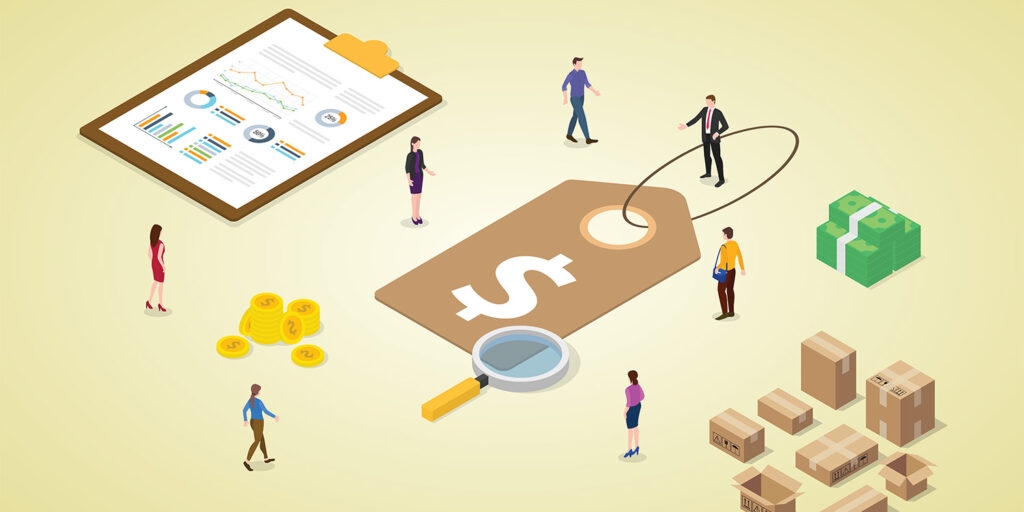The product is ready—or close to it—and you and your team are chomping at the bit to get it to market. Or perhaps you’ve already been selling the product for a while, but have realized your pricing strategy just isn’t cutting it. You’ve got some ideas for moving forward, but there’s one question that keeps tripping you up:
‘How much is this product worth?’
“Well, it cost us this much to develop,” you may say. “Let’s just throw a few bucks on top of that.”
“Sure,” a team member might affirm, “and a little more to compensate us for our time, right?”
“Yeah. We can always raise it later as we improve on it.”
This approach is a huge mistake, but software as a service (SaaS) business leaders make it all the time. In fact, Price Intelligently found businesses spend only ten hours a year working on their pricing.
This is despite the fact pricing has more impact on their bottom line than customer acquisition and retention combined. Continual pricing strategy optimization can increase your business’s recurring revenue by up to 50%.
Why does this happen? Partly, it’s due to a lack of available resources about setting a pricing strategy for subscription SaaS businesses. For example, Price Intelligently also found only 1 in 10 blog posts about subscription business growth were about pricing—well overshadowed by those about acquisition and retention.
If you’re looking for information about setting the perfect pricing strategy for your SaaS business products, you’ve come to the right place. To start, let’s take a look at your options.
There are many SaaS pricing strategies to choose from
Here at Stax Bill, we outlined the top SaaS pricing strategies for subscription businesses in our Definitive Guide to Subscription Pricing Strategy. These include:
- Freemium + upsell
- Multiple editions
- Pay-as-you-go/usage
- Base + overage
- Tiered/volume
- Stairstep
- Bundling
- Price segmentation
What’s more, some subscription businesses will find they need a hybrid pricing strategy that combines two or more of the options listed above. So how do you choose the right strategy for your business?
Choosing the right pricing strategy for your subscription SaaS business
When choosing which strategy will work for you, consider the following.
1. Business model
SaaS videoconferencing provider Zoom became functionally essential when the number of remote teams skyrocketed in March 2020. Serving such a large and effectively guaranteed customer base requires a much different approach than something more niche or luxury, like a corporate rideshare subscription.
2. Competition
If the competition only offers annual subscriptions, perhaps you can win customers over with a monthly option that makes them feel less locked in. Alternately, a pay-as-you-go option may attract customers that don’t want to spend as much as the competition is asking for. The possibilities are endless.
3. Market
The competition isn’t the only consideration in the market; you’ll need to think about timing and trends, among other things. Retailers tend to see an uptick in business during the holidays, for example and may seek software that automates some of their work to ease the burden. What pricing strategy will attract them as they prepare for the season, and keep them after things have calmed down?
4. Costs
Creating and delivering a SaaS product costs money. Your ongoing, fixed, and variable costs will likely inform the cash flow you need to keep operations running. That, in turn, may inform the strategy that’s best for you.
5. Perceived value
This is likely the most important consideration when it comes to pricing. All of the above things play a part in a potential customer’s perceived value of your product, but that doesn’t mean you can’t take steps to further influence it. Your pricing strategy should position you competitively with your target audience and customers.
Once you’ve chosen a strategy, it’s time to set your price
“One of the biggest mistakes new subscription businesses make is pricing their box too low,” Cratejoy asserts on its pricing guide.
Box subscription business leaders aren’t the only ones making pricing mistakes, of course. The Membership Guys conducted a study of subscriptions for both B2B and B2C online memberships.
It found that 45% of B2B memberships charge between $25-49/mo, and 23% charge $50-99. For B2C, 43% charge $29-49, and 23% charge $15-24.
However, those charging $50-99 made less money than those at lower price points!

Website sales software Getsitecontrol changed its SaaS pricing three times over a period of 20 months. Its final pricing model allowed for a lower entry threshold that both increased its user lifespan and doubled its purchase conversation rate.
Clearly, pricing is important. But how do you settle on an appropriate dollar amount?
Business leaders know that no matter what, they’ll need to cover their costs to stay afloat. In SaaS, these costs include things like:
- equipment and software for building the product
- digital hosting and cloud storage
- transaction fees
- marketing, and
- business software.
Every business is unique, of course, and some costs are fixed while others are variable.
On top of these costs, businesses must consider the time they spend working on the product, including marketing, sales, delivery, and customer service. How much is your team’s time worth? That’s important to include.
Your pricing needs to at least cover your costs and time, but that’s an absolute, bare-bones minimum. Pricing at this point and adding a few dollars on top is called cost-plus pricing, and it’s rarely an accurate valuation of what the product delivers. What you want is a pricing strategy that ignites growth.
Your product is more valuable than it cost you to make it
We’ve mentioned perceived value and how important it is in pricing. For B2B SaaS businesses, perceived value is often easier to hammer down: using this product for X amount of time results in X amount of revenue increase, for example.
Your product in this case is worth as much as that revenue increase. So, a SaaS subscription that increases a business’s revenue by $10,000/yr, but only costs $1,500/yr, is a steal! For the customer, your product is worth as much money as it saves or generates; use pricing that produces a high ROI for them to ensure your business’s success.
For B2C, establishing value with customers is often less black-and-white. However, that doesn’t mean it’s impossible.
How much time does your product save them, or how much easier does it make their lives? Consider the income level of your target audience and how much they’d be willing to pay to free up a few hours each week or reduce their stress levels.
Data should always have the final say
Whether establishing the customer’s perceived value is clear-cut or still murky, pricing strategy decisions need to be backed up by data. Your desired—and potential—profit margin is important to consider. But perhaps more than that, you’ll need to have a good handle on your customer acquisition cost, churn rate, and lifetime value.
These metrics will help you calculate how much it costs to acquire and keep customers, and set a pricing strategy that maximizes how much they spend over the duration of their subscription. To monitor these metrics and ensure you have complete flexibility when it comes to your evolving pricing strategy, intelligent subscription billing software like Stax Bill can help.
FAQs about Subscription SaaS Business
Q: What is a Subscription SaaS Business?
A Subscription SaaS (Software as a Service) business is a company that provides software or digital services to customers on a subscription basis, typically for monthly or annual fees.
Q: Why is the pricing strategy crucial in a Subscription SaaS Business?
Pricing strategy is essential in a Subscription SaaS Business because it can significantly influence the bottom line, affecting customer acquisition and retention. An optimized pricing strategy can heighten a business’s recurring revenue by up to 50%.
Q: What are the common mistakes in pricing strategy for Subscription SaaS Businesses?
A common mistake made by Subscription SaaS Businesses in their pricing strategy is focusing on their product’s development cost and time investment and then just topping a few dollars over it. A lack of proper resources to understand and set the right pricing strategy also contributes to these mistakes.
Q: What are the popular SaaS pricing strategies for subscription businesses?
Some popular pricing strategies for Subscription SaaS Businesses include Freemium + Upsell, Multiple Editions, Pay-as-you-go/usage, Base + Overage, Tiered/Volume, Stairstep, Bundling, Price Segmentation, and hybrid strategies combining these options.
Q: What factors should be considered when deciding on a pricing strategy for my Subscription SaaS Business?
When deciding on a pricing strategy, factors such as market competition, timing and market trends, cost of product creation and delivery, the potential customer’s perceived value of your product, and your business’s unique costs should all be considered.
Q: How does perceived value influence pricing?
Perceived value greatly affects pricing as it determines what the customer believes the product is worth. High perceived value can allow for higher price points.
Q: How does customer acquisition cost, churn rate, and lifetime values affect pricing?
These three metrics help to calculate the cost to acquire and keep customers. It enables a business to set a pricing strategy tailored to maximize how much customers spend over the duration of their subscriptions.
Q: What resources can help me with my evolving pricing strategy in my Subscription SaaS Business?
Intelligent subscription billing software like Stax Bill can aid in tracking essential metrics for your pricing strategy and provide complete flexibility as your pricing strategy evolves.
Q: Can a SaaS business pricing model influence its performance?
Yes, the choice of a pricing model can have a profound impact on the success of a SaaS business. A suitable pricing model not only helps attract customers but also plays a key role in customer retention.
Q: What is cost-plus pricing in a Subscription SaaS Business?
Cost-plus pricing is setting a price by adding a few dollars on top of the cost to build a product. While this might cover costs and provide a minimal profit, it may not accurately reflect the product’s real value or consider potential business growth.








